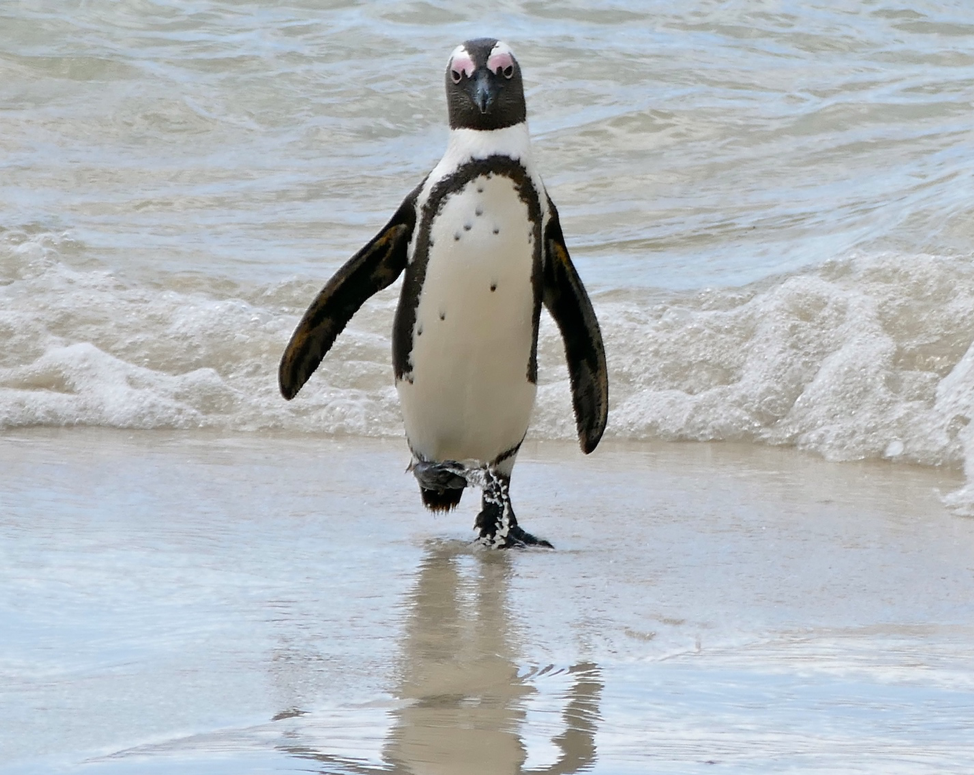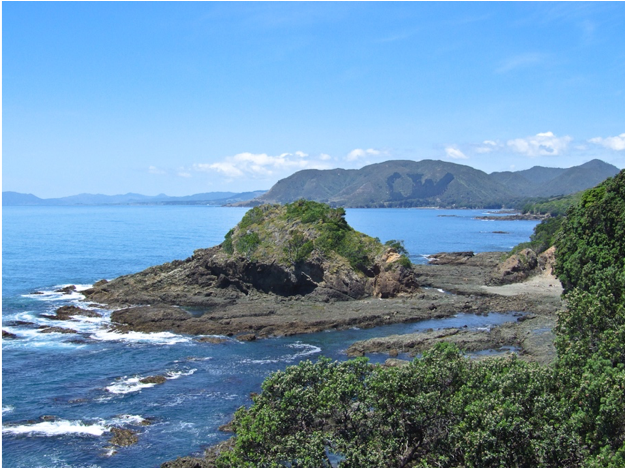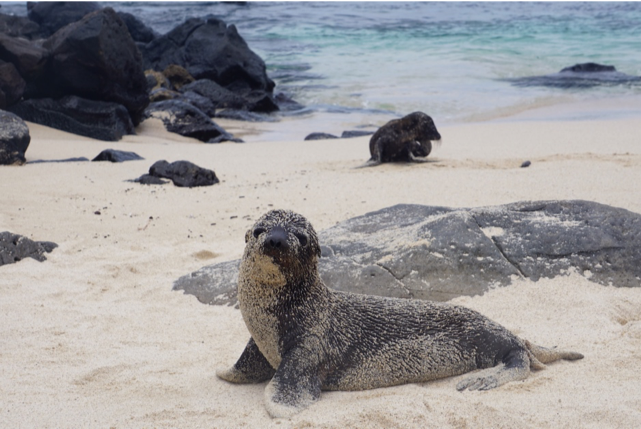Rights of the Pacific Ocean Initiative
Figure 1 Endangered African Penguin by Bernard DUPONT from FRANCE (CC BY-SA 2.0)
By Celeste Coughlin
The United Nations hosted the first-ever United Nations Ocean Conference in 2017, to create an action plan surrounding the enforcement of Sustainable Development Goal 14 on the conservation and sustainable use of the oceans. This conference was the culmination of years of ocean rights advocacy work. Notably, the conference embraced the future of legal rights of the ocean. Alongside Cook Island Prime Minister Henry Puna urging recognition of the Rights of the Ocean, Earth Law Center presented its Ocean Rights Initiative to the UN General Assembly. The initiative, signed by over 70 organizations from 32 countries, urged the United Nations, governments and practitioners to adopt a holistic and rights-based approach to ocean governance.
The Institut de Recherche pour le Développement (IRD) in partnership with the Secretariat of the Pacific Regional Environment Programme (SPREP), Conservation International Pacific Islands Programme and Centre International de Droit Comparé de l'Environnement (CIDCE) also launched a voluntary commitment at the United Nations Ocean Conference.
The commitment includes a feasibility study leading to the drafting of a regional convention, open to all signatories by 2020, recognizing the Pacific Ocean as a legal entity with its own legal rights. Such a framework has been successfully applied in New Zealand (the Whanganui River, Te Urewera National Park and Mount Taranaki), in India (Narmada River) and in Colombia (Colombian Amazon, Pisba Highlands and Atrato River).
In November 2018, 22 participants from 8 countries, including Earth Law Center, attended a two-day gathering in New Zealand on the feasibility of such an idea. Together, participants agreed it was worth pursuing and produced a statement based on the collective thinking of those present. The statement reiterates the kinship Pacific Islanders have with the Ocean and the recognition that the Ocean is an entity, a being, and our source of life. A regional (or international) convention to legally recognize and protect the Rights of the Pacific Ocean is one way that Pacific Islanders can begin to develop a system that helps them adapt, mitigate and address the root cause of climate change.
The Statement is the first step by participants of the gathering towards advancing a paradigm shift in how we treat the Ocean, and signals intent to preserve the ocean for all life for future generations. Next steps identified by those present include: creating a questionnaire for Island Nations to provide input, research and drafting of how a new regional convention will comply with and advance existing laws, and conducting outreach and education to mobilize widespread support.
“We have a responsibility and obligation to conserve, protect and defend the rights of the Ocean; the rights of past, present and future generations of all beings rely on respect for the rights of the Ocean.” Statement of the Collective thinking.
With this powerful call to action in mind, we look to the various examples of Rights of Nature already in place within Island Nations.
Figure 2 Humpback whale (Megaptera novaeangliae) near its whale calf, breaching off to keep away males.(Tahiti, French Polynesia) © Jérémie Silvestro / Wikimedia Commons
Pacific Island Nations & Biodiversity
The Pacific Island nations are made up of 18 Pacific Island Countries and Territories, 30,000 individual islands, and thousands of square kilometers of coral reef that has been mapped and tracked over the last 5 decades. The 7 million people who are citizens of the Pacific Island Countries who depend on the coral reefs as a part of their daily life rely on the sustainability of the reefs.
These island reefs are home to 30% of all of oceanic life. The unique climate and rich biodiversity make the Pacific Islands a true bio-gem. This part of the world is often written off by Western culture as undeveloped, but it is this particular lack of development that has allowed many types of ocean life to flourish and thrive in the tropical waters of the Pacific Islands.
Figure 3 Map of the Cook Islands
Cook Islands
The Cook Islands created the Te Marae Moana Sanctuary in 2017. The Prime Minister of the Cook Islands said at the UN Ocean Conference, "[W]e must consider the rights of the ocean. For just as those who have been treated unfairly have found it necessary to fight for and claim their rights, so too has the ocean been treated with injustice and disrespect. And so now we find it necessary to fight for the rights of the ocean.”
The sanctuary is “the world's largest integrated ocean management system.” Te Marae Moana is considered “the largest commitment by any country to integrate ocean conservation and management from ridge to reef and beyond.”
The primary purpose is the protection and conservation of the ecological, biodiversity and heritage values established by native Cook Islanders. Established over the entire Cook Islands marine space, the act also encompasses 1000 meters above in the air and 1000 meters below the seabed, which lends itself to three dimensional protections to prevent future oil pipelines. The secondary purpose is integrated management which focuses on stakeholder participation. Economic use is the tertiary priority.
Creating the Sanctuary in this way, signifies a transition from most Marine Protected Areas. Here, the entire space is created with the highest level of protection. In fact, they protected the whole area outright, and do not allow large scale fishing and seabed mineral activities within 50 nautical miles of the islands. Now that everything is protected, they then decide if and where activities are permitted through a process of impact studies, advisory opinions and council approval. This means that if activities like fishing or seabed mining are on the table, those wishing to undertake those activities must make the case that it will be consistent with the primary purpose of conservation.
Figure 4 Bay on North Shore, New Zealand by Abaconda Management Group from New Zealand (CC BY-SA 2.0)
New Zealand
New Zealand leads the world in legal personhood legislation having designated a national park, river and sacred mountain as legal persons. This feat has allowed the sustainable conservation of natural resources to continue unimpeded.
In March of 2017 New Zealand passed its first legal personhood law protecting the land of Te Urewera. The forested area began its journey as a national park that was turned back to its original inhabitants; the Ngāi Tūhoe people as part of an agreement that acknowledges the ‘Mist People’s deep connection with the land there.
Secondly, the Māori tribe of Whanganui in the North Island of New Zealand has won recognition for the Whanganui River as an ancestor for 140 years. This recognition of the Whanganui river as a person with two appointed representatives from the government and from the tribe serves as a template for the rest of New Zealand’s native people to follow as well.
Most recently, we see the Taranaki volcano granted rights to personhood too. Mount Taranaki is categorized as a dormant volcano. The mountain lies in the Egmont national park and is the first mountain in New Zealand to be awarded the status of personhood.
Lastly, the Hauraki Gulf is a coastal bay off the Northern Island of New Zealand. It is a protected wildlife area established in 2000. The gulf is home to many endangered species of marine animals, award winning wineries, and wilderness sanctuaries. Though the Hauraki Gulf initiative does not specifically codify legal rights for the Park, the Sea Change Marine Spatial Plan proposes the recognition of the Park’s rights by calling on communities “to think of the environment as having its own rights.” It also creates the guardianship system with the local native people and extends guardianship to all.
New Zealand's recognition of these peoples’ ties to the world sets forward a powerful precedent in moving the rights of the Pacific Ocean forward.
Australia
The Australian Parliament passed the Water Act of 2007 and as a result, water is protected under the law. This act doesn’t recognize the rights of nature or grant the rights of personhood but it’s a bureaucratic measure to regulate the means of water extraction and use across the continent without granting water the rights to personhood per se. This is one means of managing resources that has proved effective in Australia.
Figure 5 Bondi Beach, Australia by Alex King on Unsplash
As the driest continent in the world, Australia has to consider its resource use carefully. Assigning rights to creeks, lakes, and harbors is a good first step but as an island continent they can do more by extending their moral identification and sympathy to the Pacific as a whole. This will also better defend the rights and cultures of natives to Australia, New Zealand, and the Pacific Islands.
New Caledonia
In New Caledonia, a French sovereign state, the Kanak Charter states, "the lands, resources and natural space as well as the tangible and intangible traditional knowledge attached to it constitute the natural heritage of the Kanak people, for which it is the guarantor and custodian in the eyes of future generations." This led to the development of new law, the environmental code, that states "man belongs to the natural environment which surrounds him and conceives his identity in the elements of this natural environment which constitutes the founding principle of Kanak society. In order to take into account this conception of Kanak life and organization, certain elements of Nature may be recognized as having legal personality with their own rights, subject to the laws and regulations in force." This provides the starting foundation needed for recognition of the Pacific Ocean as a legal entity with rights.
What would the Convention mean for Island Nations?
The Pacific Island Nations face rapid land loss and possible extinction because of rising sea levels, further erosion of legal protection, and a warming planet. This threatens the 7 million people living among the island nations. Today we have an opportunity to work with these communities to build legal protection for the resources that are so valuable not just to those communities but to each of us.
Recognizing the Rights of the Pacific Ocean would begin building sustainable models for growth and protection. The Convention represents the first major step towards rights of nature law in the region coupled with a plan to closely monitor these systems to ensure their effectiveness.
Codified protection of the Pacific Ocean grants power to indigenous peoples and would designate Pacific Islanders as the guardians of the Pacific Ocean, providing the traditional knowledge needed to understand the Oceans’ limits and how to create a harmonious relationship with the Ocean. This would also empower Pacific Islanders to build businesses surrounding the Ocean, as they deem appropriate, that support and conserve the Ocean while providing for jobs and livelihoods.
This, of course, would not be without an outside check. Similar to the set up of the Te Urewera Act, it is likely that there would be a two pronged check and balance management system to the Pacific Ocean Rights.
Further benefits from the Convention on the Rights of the Pacific Ocean include:
Local communities gain the right to defend marine ecosystems from harm
Indigenous nations regain economic power from legal recognition of the long-standing relationship they have with their local ecosystems
Figure 6 Baby Sea Lion, Galapagos. By Michelle Bender.
Finally, the Convention would redress accountability for greenhouse gas emissions. Whereas the current system gives the Kingdom of Toga the same burden as the People’s Republic of China without any regard for their contribution to climate change – the new Convention would also recognize that the Pacific Islanders have in fact contributed very little to greenhouse gas emissions.
We depend on the ocean for our well-being so it’s time to start taking care of marine ecosystems. That protection means recognizing Rights for the Pacific Ocean so we can restore and protect ocean health. Won’t you join us?
To support the growing global movement for Earth Law:
Read ELC’s first ebook here
Sign up for our monthly newsletter






